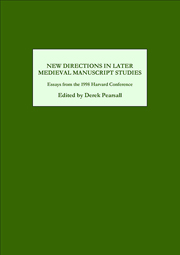Book contents
- Frontmatter
- Contents
- List of Illustrations
- Acknowledgements
- Introduction
- Recent Directions in Medieval Manuscript Study
- Another Fine Manuscript Mess: Authors, Editors and Readers of Piers Plowman
- A New Approach to the Witnesses and Text of the Canterbury Tales
- Prospecting in the Archives: Middle English Verse in Record Repositories
- Medieval Manuscripts and Electronic Media: Observations on Future Possibilities
- Representing the Middle English Manuscript
- Skins, Sheets and Quires
- Reconsidering the Auchinleck Manuscript
- Professional Readers of Langland at Home and Abroad: New Directions in the Political and Bureaucratic Codicology of Piers Plowman
- Professional Scribes? Identifying English Scribes Who Had a Hand in More Than One Manuscript
- Manuscript Production in Medieval Theatre: The German Carnival Plays
- The ‘Lancelot-Graal’ Project
- After Chaucer: Resituating Middle English Poetry in the Late Medieval and Early Modern Period
- Notes on Contributors
- Index
The ‘Lancelot-Graal’ Project
Published online by Cambridge University Press: 05 September 2014
- Frontmatter
- Contents
- List of Illustrations
- Acknowledgements
- Introduction
- Recent Directions in Medieval Manuscript Study
- Another Fine Manuscript Mess: Authors, Editors and Readers of Piers Plowman
- A New Approach to the Witnesses and Text of the Canterbury Tales
- Prospecting in the Archives: Middle English Verse in Record Repositories
- Medieval Manuscripts and Electronic Media: Observations on Future Possibilities
- Representing the Middle English Manuscript
- Skins, Sheets and Quires
- Reconsidering the Auchinleck Manuscript
- Professional Readers of Langland at Home and Abroad: New Directions in the Political and Bureaucratic Codicology of Piers Plowman
- Professional Scribes? Identifying English Scribes Who Had a Hand in More Than One Manuscript
- Manuscript Production in Medieval Theatre: The German Carnival Plays
- The ‘Lancelot-Graal’ Project
- After Chaucer: Resituating Middle English Poetry in the Late Medieval and Early Modern Period
- Notes on Contributors
- Index
Summary
This essay describes the rationale for the pilot phase of a computer data-base of text and pictures that we hope will eventually form a Corpus of ‘Lancelot-Graal’ manuscripts, will present a model for manuscript analysis in general, and will have a range of other applications beyond the field of manuscript studies. An international team of Old French specialists (Keith Busby, Elspeth Kennedy, Roger Middleton) and art historians and manuscript specialists (Susan Blackman, Martine Meuwese, Alison Stones) are collaborating with technical consultants in information science and telecommunications (Kenneth Sochats, Guoray Cai) to create and use a searchable database of primary manuscript pages and secondary commentary linked to a searchable database of images. The specialists will use the database to generate a variety of products, both in the traditional form of books and articles, and in electronic form on the World Wide Web and CD-ROMs.
What we hope to learn is more about the intentions of the makers of the manuscripts and those (patrons? directors of operations?) who guided them in the choices they made. Our work to date shows that the choice, placement and composition of the illustrations varies very considerably from one manuscript to another, even among copies produced by the same scribes, decorators and artists. Certain manuscripts display at times a very surprising degree of careful attention to the nuances the text in that copy conveys. Illustrations showing the same episode in other copies will not necessarily present a comparably text-dependent picture. We are looking at which, where and how, in the hopes of moving a step closer to understanding why.
- Type
- Chapter
- Information
- New Directions in Later Medieval Manuscript StudiesEssays from the 1998 Harvard Conference, pp. 167 - 182Publisher: Boydell & BrewerPrint publication year: 2000



